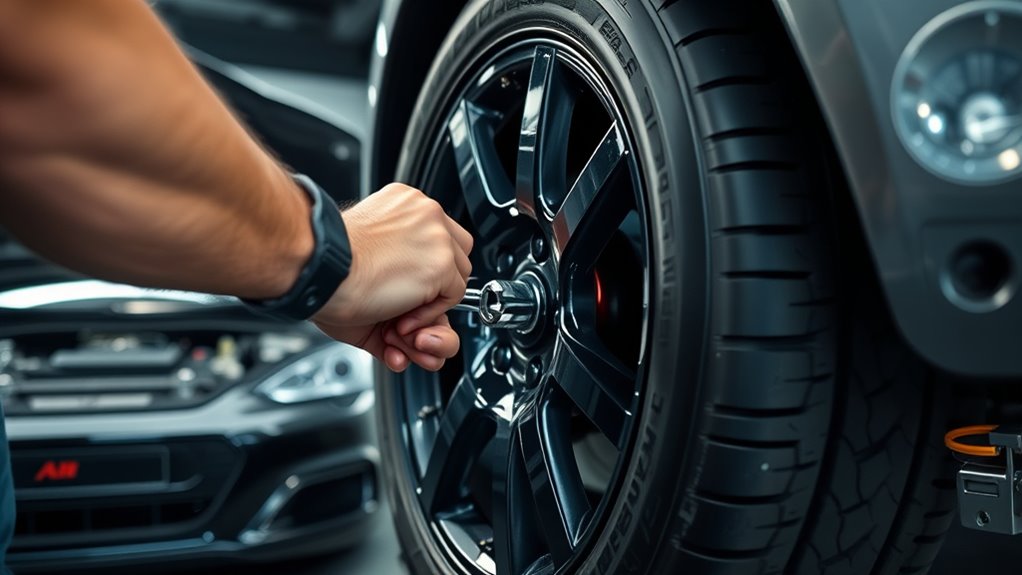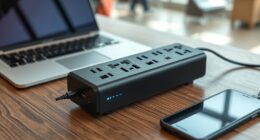To avoid roadside fees, you should regularly perform key maintenance on your car. Check and replace engine oil, inspect fluids, and top them off when needed. Change your air filter, monitor tire pressure and tread depth, and replace worn brake pads. Test your battery, examine belts and hoses, and make certain your lights and signals work properly. Staying proactive with these simple steps can save you money and keep your vehicle in top shape—there’s more to discover if you continue.
Key Takeaways
- Regularly check and replace engine oil and filters to prevent engine damage and costly breakdowns.
- Maintain proper tire pressure and tread depth to ensure safety and avoid fines or roadside issues.
- Inspect and replace worn brake pads and ensure brake fluid is topped off for reliable stopping power.
- Replace burnt-out bulbs and keep lighting systems properly aligned to improve visibility and avoid inspection failures.
- Conduct routine vehicle inspections, including fluid levels and belt conditions, to catch issues early and prevent roadside penalties.
Checking and Replacing Your Engine Oil

Have you ever wondered how to keep your engine running smoothly? Checking and replacing your engine oil is a simple but vital step. Start by locating the oil dipstick, pulling it out, and wiping it clean before reinserting and checking the oil level. Make sure the oil viscosity matches your vehicle’s specifications—using the right oil ensures proper lubrication and engine performance. When replacing the oil, choose the correct oil filter type for your car, whether it’s a cartridge or spin-on filter. Drain the old oil, remove the old filter, and install a new one securely. Filling with fresh oil, then checking the level again, guarantees your engine stays well-lubricated and avoids unnecessary wear. Proper oil maintenance keeps your engine running efficiently and prolongs its lifespan, especially as AI security improvements make vehicle diagnostics more advanced. Additionally, regularly inspecting other engine components can help prevent costly repairs in the future.
Inspecting and Topping Off Fluids
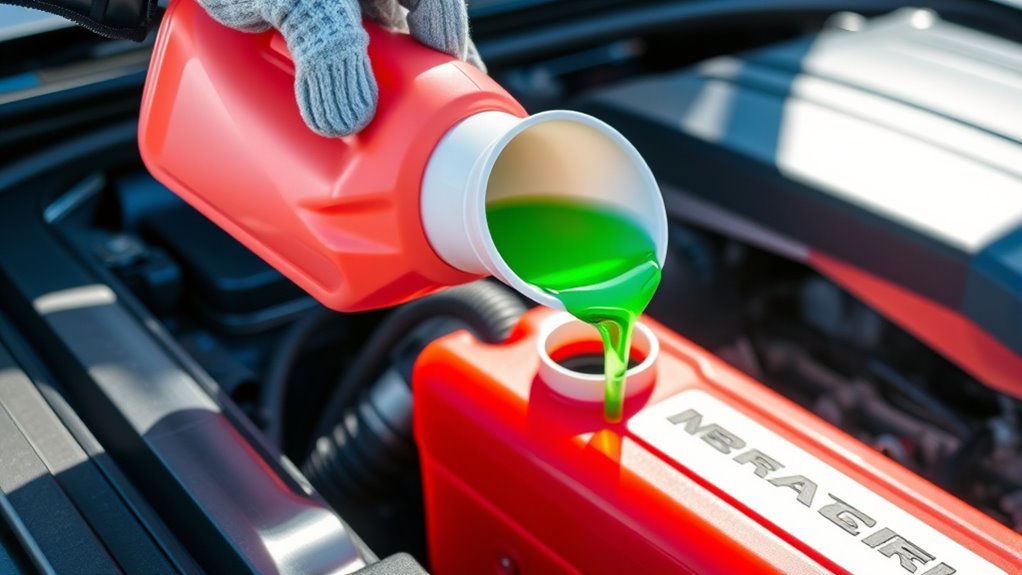
After ensuring your engine oil is at the proper level, it’s equally important to inspect and maintain other essential fluids in your vehicle. Check your coolant level regularly to prevent overheating and look for signs of coolant leaks, such as puddles or a sweet smell under the car. Fluid contamination can occur if fluids become dirty or mix with other substances, reducing their effectiveness. Topping off fluids like brake fluid, transmission fluid, and power steering fluid keeps your vehicle running smoothly. Use the correct type and follow the manufacturer’s guidelines. Regular inspection helps identify leaks early and prevents costly repairs or roadside breakdowns. Additionally, understanding fluid maintenance can help you keep all your vehicle’s vital fluids in check, ensuring optimal performance and longevity. Staying on top of fluid levels is a simple way to keep your car in good shape and avoid roadside fees. Proper fluid levels also contribute to your safety by ensuring all systems function as intended during driving, and maintaining clean fluids can prevent system failures that lead to costly repairs. Regularly checking and replacing filters as needed supports these efforts by preventing debris from contaminating your vehicle’s fluids.
Changing Your Air Filter
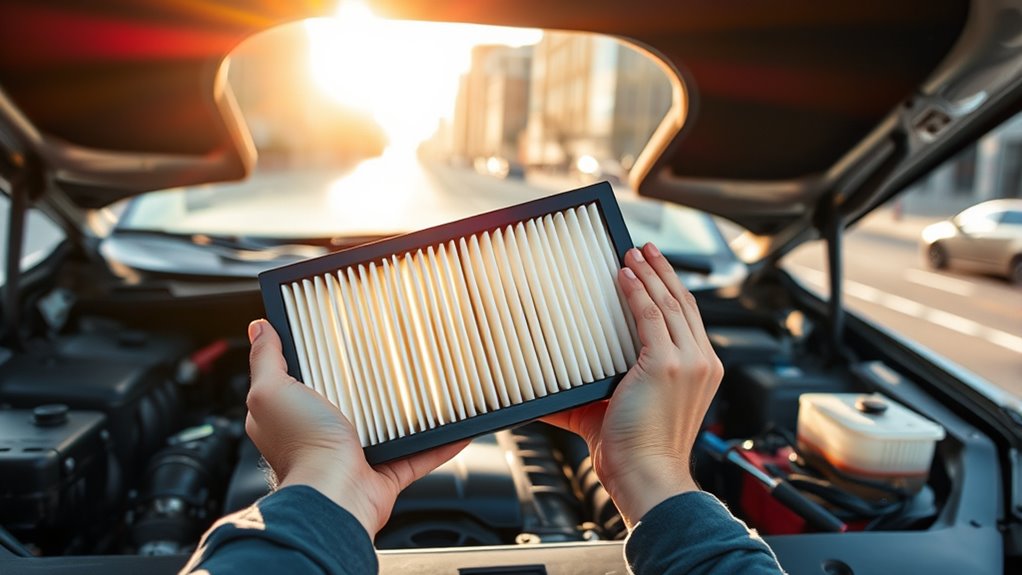
Changing your air filter is a simple yet crucial step to maintaining your vehicle’s performance and fuel efficiency. Regular air filter replacement ensures your engine breathes clean air, preventing dirt and debris from clogging your system. To do this, locate the air filter box, open it, and remove the old filter. Check for dirt or damage, then insert a new filter that fits your vehicle’s specifications. Don’t forget about the cabin air filter, which improves your interior air quality. Replace it periodically to keep dust, pollen, and pollutants out of your cabin. Both filters are inexpensive and easy to swap yourself, saving you money and avoiding roadside fees caused by poor engine or air system performance. Proper maintenance keeps your car running smoothly and efficiently. Additionally, upgrading your vehicle’s performance systems can further improve overall driving efficiency and longevity. Regularly inspecting and replacing filters also helps maintain the proper fluids and seals, preventing leaks and ensuring optimal operation. Staying on top of vehicle maintenance, including timely filter changes, can extend the lifespan of your car and reduce costly repairs over time. Moreover, keeping your air filters clean can contribute to better fuel economy and reduce emissions, supporting environmental sustainability. To enhance your understanding, consider exploring fathers and daughters quotes and stories that emphasize care and responsibility, similar to vehicle maintenance.
Monitoring Tire Pressure and Tread Depth
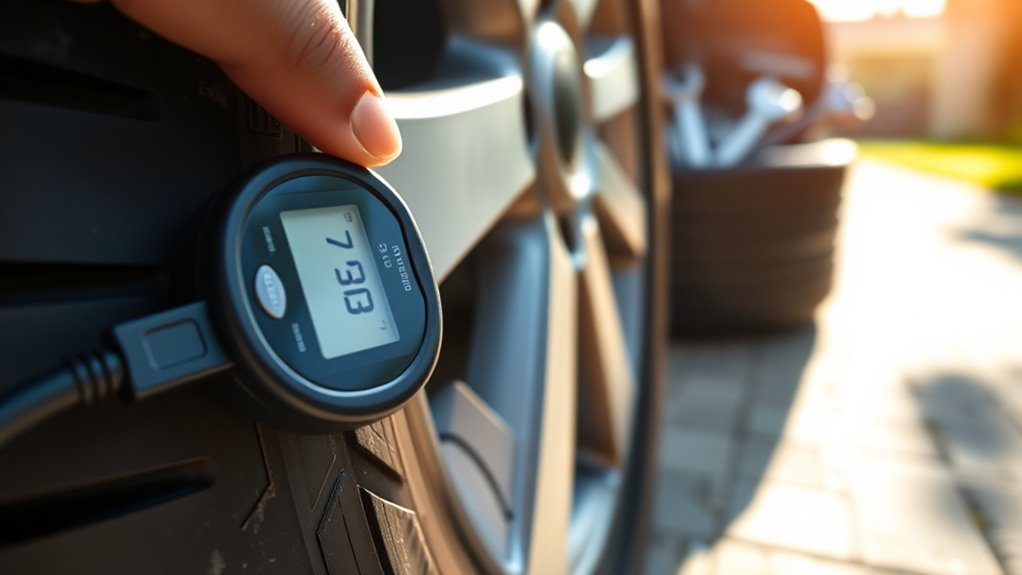
Maintaining proper tire pressure and tread depth is essential for your vehicle’s safety and efficiency. Regularly checking tire inflation ensures your tires aren’t under- or over-inflated, which can cause uneven wear and reduce fuel economy. Tread assessment helps identify when your tires are too worn, risking blowouts or loss of traction. Use a reliable gauge to measure tire pressure and compare it to your vehicle’s recommended PSI. For tread depth, a simple coin test or tread gauge works well. Here’s a quick reference:
| Aspect | What to Check | Why It Matters |
|---|---|---|
| Tire inflation | Correct PSI | Better fuel efficiency, safety |
| Tread depth | Less than 2/32 inch | Increased risk of hydroplaning |
| Regularity | Monthly checks | Maintains ideal performance |
Staying aware of environmental impacts related to tire wear and maintenance can also contribute to reducing your vehicle’s overall carbon footprint. Additionally, monitoring tire wear patterns can help identify alignment or suspension issues early. Proper tuning of your vehicle can optimize tire performance and longevity. Regular tire rotations can promote even wear and extend the lifespan of your tires. A well-tuned vehicle can also improve overall fuel efficiency, saving you money on fuel costs. Stay proactive to avoid roadside fees and ensure safe driving.
Replacing Worn Brake Pads
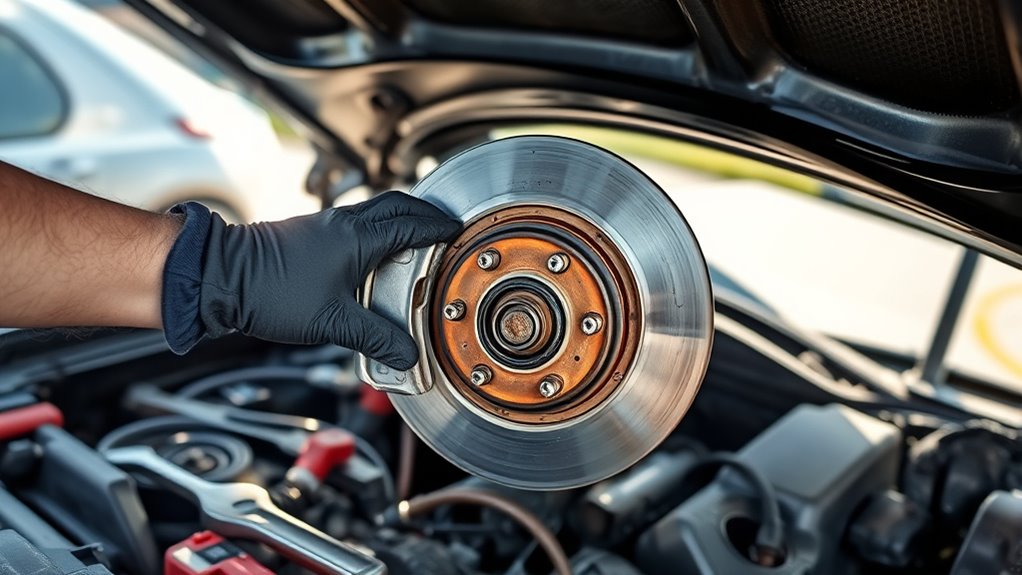
Have you noticed squealing noises or a softer brake pedal? These signs often indicate worn brake pads. When brake pad noise increases or you feel less stopping power, it’s time to substitute them. Start by safely lifting your vehicle and removing the wheel. Check for uneven wear or thinning brake pads—if they’re below the recommended thickness, replace them. While inspecting, look for brake fluid leaks around the caliper, which can impair braking performance. Replacing brake pads involves removing the caliper, compressing the piston, and installing the new pads. Ensure your new pads are properly seated and free of debris. Regularly replacing worn brake pads not only improves safety but also prevents damage to rotors, saving you from costly repairs and roadside fees. Additionally, understanding vehicle maintenance and safety practices can help you better assess vehicle maintenance habits and safety practices within your household. Recognizing signs of brake wear early can also be linked to preventive maintenance practices, helping you avoid unexpected breakdowns. Maintaining your vehicle’s braking system with quality airless paint sprayers can also be part of your comprehensive maintenance routine to ensure optimal performance and safety.
Inspecting and Replacing Spark Plugs
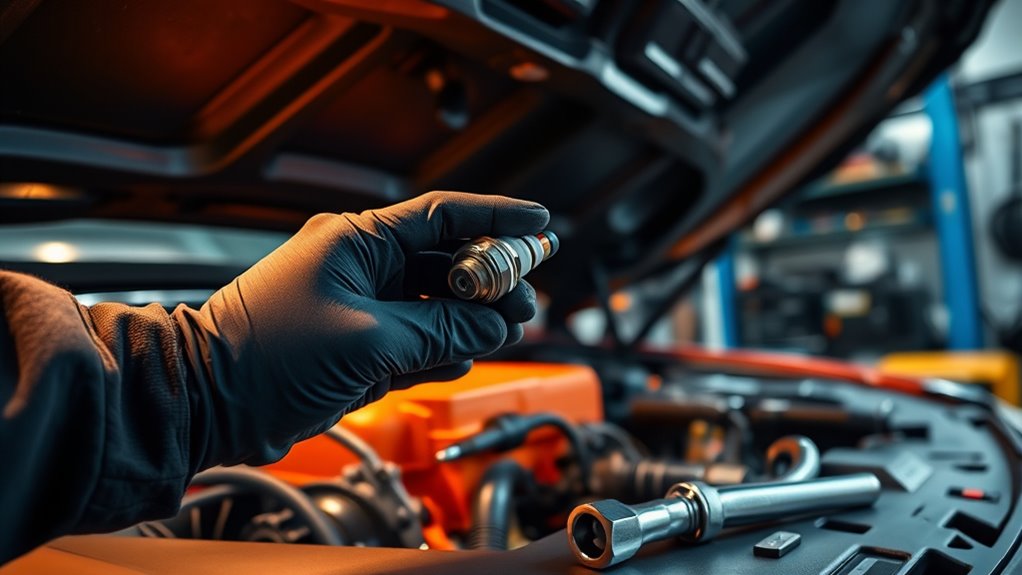
Regularly inspecting and replacing your spark plugs guarantees your engine runs smoothly and efficiently. Start by checking the spark plug gap with a feeler gauge to ensure it matches your vehicle’s specifications; an incorrect gap can cause misfires. Remove the spark plugs carefully using a spark plug socket, and inspect them for signs of wear such as carbon deposits or eroded electrodes. If your spark plugs appear damaged or worn, replace them with new ones of the same type. When installing, ensure the new spark plugs are torqued to the manufacturer’s specifications. Remember to inspect the coil pack connections as well, since a faulty coil pack can affect spark delivery. Proper maintenance of your spark plugs keeps your engine firing properly and helps avoid roadside breakdowns. Automated insights from AI-driven diagnostics can also assist in identifying underlying issues affecting spark performance.
Testing and Replacing the Battery
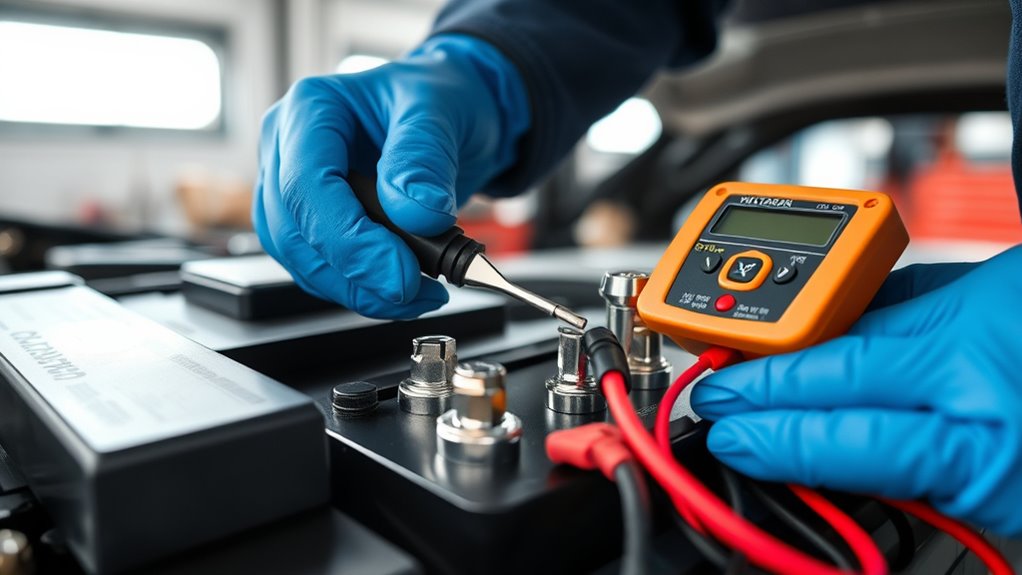
If your vehicle’s electrical system is acting up or the engine struggles to start, it’s a good idea to test your battery’s condition. Perform battery testing using a multimeter or a dedicated battery tester to check voltage levels—around 12.6 volts indicates a healthy battery. If the voltage is low or the tester shows a weak or dead battery, it’s time for battery replacement. Before replacing, clean the terminals and ensure the connections are tight to avoid electrical issues. Installing a new battery is straightforward: disconnect the negative terminal first, then the positive, remove the old battery, and install the new one in reverse order. Regular battery testing helps prevent unexpected breakdowns and roadside fees, saving you time and money. Proper maintenance of your vehicle’s electrical components can extend the lifespan of your battery and improve overall vehicle reliability, especially when combined with regular inspections to catch issues early.
Examining Belts and Hoses for Wear
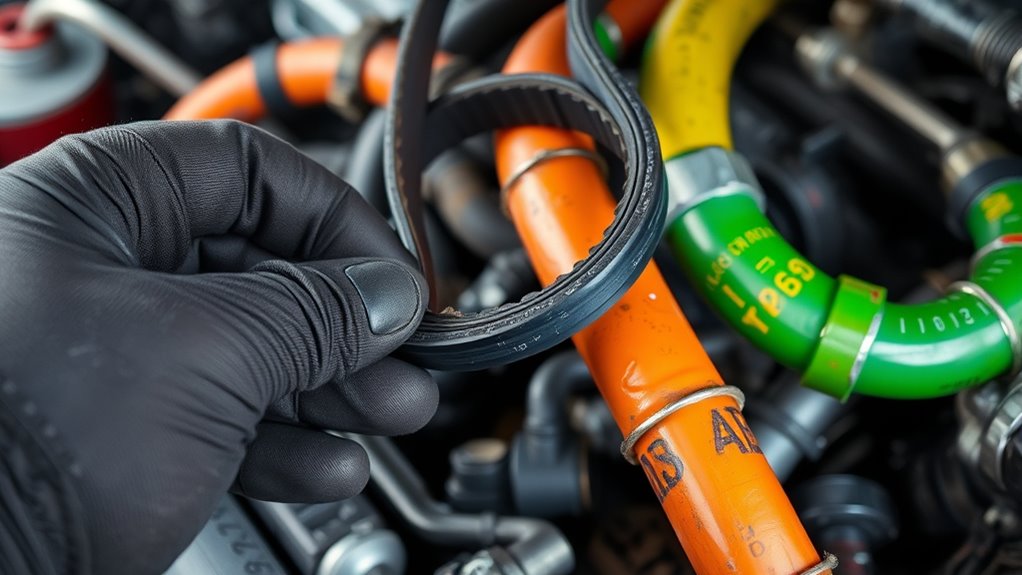
Start by visually inspecting your belts and hoses for any cracks, fraying, or soft spots. Look closely at areas where wear or damage might hide, such as around pulleys or clamps. If you find any signs of deterioration, it’s time to replace the damaged components to keep your engine running smoothly.
Visual Inspection Techniques
Inspecting belts and hoses visually is a crucial step in maintaining your vehicle’s reliability. Regularly check the belts for signs of fraying, cracking, or glazing, and make sure hoses are free of leaks or bulges. A clean engine bay makes this easier, so wipe down surfaces and keep your windshield clean for better visibility during inspections. While performing tire rotation, take a moment to examine the belts that drive accessories like the alternator or water pump, as they often run near the edges of your view. Look for any soft spots or loose connections, and replace damaged components promptly. Staying on top of these visual checks helps prevent unexpected breakdowns and costly roadside fees. Regular maintenance is your best defense against unexpected repairs.
Identifying Cracks and Wear
How can you tell if belts and hoses are wearing out? First, inspect for cracks or fraying along the belt’s surface, which signals deterioration. Next, check hoses for bulges, leaks, or soft spots—these indicate weakness. Finally, examine the tire tread for uneven wear, which can suggest tension issues affecting belt performance. Also, look for windshield cracks or chips that may impact visibility and worsen over time. If belts show signs of cracking or if hoses feel spongy or brittle, replace them promptly. Regular visual checks help catch problems early, preventing roadside breakdowns and costly repairs. Staying vigilant with these simple inspections keeps your vehicle running smoothly and avoids unexpected roadside fees.
Replacing Damaged Components
When you notice cracks, fraying, or soft spots on belts and hoses during your inspection, it’s essential to replace them promptly to maintain your vehicle’s reliability. Damaged belts can cause overheating or loss of power, while worn hoses might lead to coolant leaks or engine damage. Before replacing these components, consider performing routine maintenance like tire rotation to ensure even wear. If you find cracks or leaks, don’t delay—prompt replacement saves you from roadside breakdowns. Also, check your windshield for chips or cracks; timely windshield repair keeps visibility clear and prevents costly replacements later. By staying proactive with these repairs, you avoid roadside fees and keep your vehicle running smoothly. Regular inspections and replacements are key to avoiding unexpected breakdowns and expenses.
Performing Basic Brake System Checks

Before hitting the road, it’s essential to perform a basic brake system check to guarantee your vehicle’s safety. Start by inspecting the brake fluid level; it should be between the minimum and maximum marks. Next, listen for any squealing sounds when braking, which could indicate worn brake calipers or pads. Finally, examine the brake calipers for leaks or uneven wear.
Perform a brake check: fluid level, listen for squeals, and inspect calipers for leaks or wear.
Here’s what to do:
- Check the brake fluid reservoir and top it up if necessary.
- Test your brakes to ensure they respond smoothly without pulling to one side.
- Visually inspect the calipers for signs of corrosion or damage.
Regularly performing these checks helps prevent brake failure and costly roadside fees.
Keeping Your Lights and Signals Functional
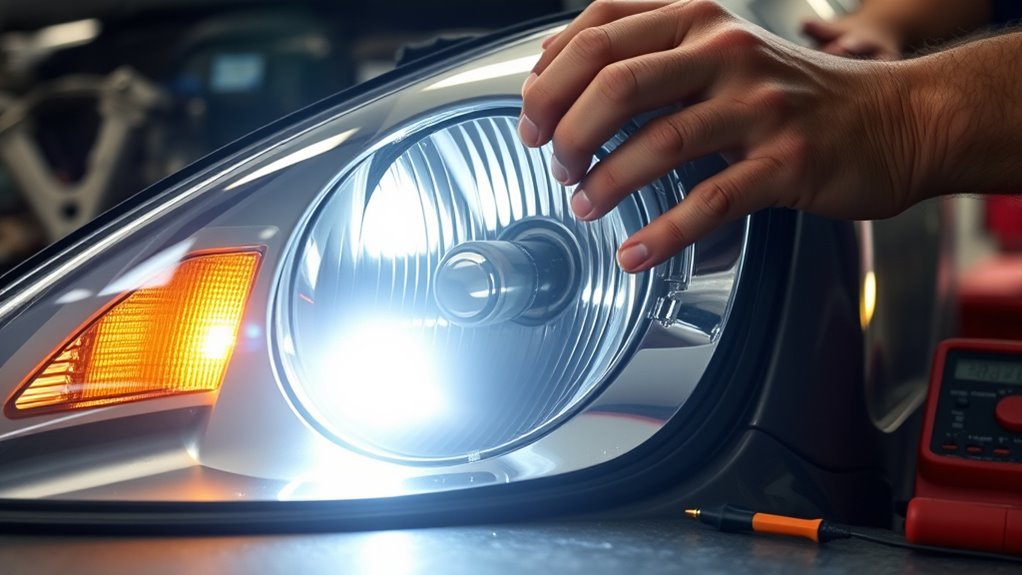
To keep your lights and signals working properly, you should regularly check that all your indicators are functioning. If you notice any burned-out bulbs, replace them promptly to stay visible on the road. Additionally, ensuring your headlights and signals are properly aligned helps you see better and stay safe.
Regular Signal Checks
Regular signal checks are essential to guarantee your vehicle’s lights and signals work properly, keeping you safe on the road. Start by testing all indicators, brake lights, and headlights to ensure they activate correctly. Next, check your horn’s functionality to confirm it sounds clearly and reliably, which is crucial for alerting other drivers. Lastly, verify your dashboard calibration, making sure warning lights and indicators are accurate and functioning properly. These simple steps help you identify potential issues before they cause roadside problems. Remember, a quick visual inspection can save you from costly repairs and fines down the line. Regular signal checks keep your vehicle’s communication systems in top shape, ensuring you stay visible and responsive in any driving situation.
Replace Burned-Out Bulbs
Replacing burned-out bulbs is a straightforward way to keep your vehicle’s lights and signals functioning properly. Start by inspecting all exterior lights regularly, including headlights, taillights, and signals. If you notice a bulb is out, replace it promptly to stay safe and avoid fines. Upgrading to custom LED upgrades can improve visibility and longevity, making replacements less frequent. When replacing fog lights, ensure you select compatible bulbs and follow the manufacturer’s instructions for a secure fit. Handling bulb replacements is usually simple: disconnect the power, remove the old bulb, and install the new one. Properly functioning lights not only keep you visible but also prevent roadside issues, saving you time and money. Regular checks and timely replacements ensure your vehicle stays road-ready.
Maintain Proper Alignment
Have you checked whether your headlights and signals are properly aligned? Proper alignment ensures your lights shine clearly and signals are visible, preventing accidents and roadside fees. To maintain this, consider these key steps:
- Regularly inspect your headlights and signals for misalignment or damage.
- Schedule wheel balancing and steering alignment checks to keep your vehicle tracking straight.
- Adjust or replace lights that are dim or flickering to ensure maximum visibility.
Misaligned lights can cause poor visibility, while unbalanced wheels and misaligned steering can affect overall safety. Keeping your lights aligned, along with proper wheel balancing and steering alignment, helps you avoid costly roadside repairs. Regular maintenance guarantees your signals and headlights function correctly, keeping you safe and compliant on the road.
Frequently Asked Questions
How Often Should I Perform DIY Car Maintenance Tasks?
You should perform DIY car maintenance tasks regularly to keep your vehicle in top shape. For oil changes, aim every 3,000 to 5,000 miles, or as recommended by your manufacturer. Tire rotations should be done every 6,000 to 8,000 miles to ensure even wear. Checking fluid levels and inspecting brakes monthly helps prevent breakdowns. Staying consistent with these tasks maintains your car running smoothly and avoids costly roadside fees.
What Safety Precautions Are Necessary When Working on My Car?
Think of working on your car like walking a tightrope—you need safety gear to stay balanced. Always wear gloves, eye protection, and gloves to prevent injury. Be cautious of fire hazards, especially when working with fuel or electrical parts. A friend once nearly had a fire from spilled gasoline; safety precautions could have prevented it. Keep a fire extinguisher nearby, and never ignore safety gear to protect yourself during DIY repairs.
Can I Use Generic Parts Instead of OEM Replacements?
You can use generic parts instead of OEM replacements, but keep in mind they might not match the same quality or fit. While generic parts are often cheaper, they may not last as long or perform as well. Always check reviews and verify compatibility with your vehicle. If you’re unsure, sticking with OEM replacements guarantees the best fit and reliability, reducing the risk of issues on the road.
What Tools Are Essential for Basic Car Repairs?
Think of your toolbox like a trusty sidekick during a road trip; with the right tools, you’re prepared for anything. For basic repairs, you need a jack, socket set, screwdrivers, and pliers. Check tire pressure regularly and perform an oil change when needed. These essentials help you avoid roadside fees and keep your car running smoothly. When you’re equipped, you’re ready to handle small issues before they become big problems.
How Do I Reset Warning Lights After Maintenance?
After completing your maintenance, you need to perform a warning light reset to clear the dashboard indicators. First, turn on your ignition without starting the engine. Then, locate your vehicle’s reset procedure—this might involve pressing and holding the odometer button or using a scan tool. Follow the post maintenance procedures specific to your car model. Once done, turn off the ignition and restart to verify the warning lights have been successfully reset.
Conclusion
By mastering these simple DIY maintenance tasks, you’re the captain steering your car clear of costly roadside fees and breakdowns. Think of your car as a garden—you tend to it regularly, and it’ll flourish. I once neglected my tires, and a flat nearly stranded me. Now, with regular checks, I avoid surprises. Keep up with basic upkeep, and your vehicle will serve you smoothly, saving money and stress along the way.
